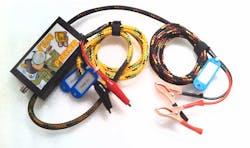Tech Tip: Current ramping as a useful diagnostic technique
Current ramping is one of the most powerful diagnostic techniques available to the modern automotive technician. It is by far the fastest and least intrusive way of assessing the working condition of an electronic circuit. It is also very unlikely to be confused or misguided by the results of a current ramping waveform analysis. Current is the amount of electrons flowing through a conductor (wire). The thicker (lower wire gauge number) the electrical wire the more current (electrons) that can flow though it and it's connected device (motor, solenoid, valve, etc).
It is virtually impossible to have a circuit or component with the correct current signal waveform and be defective, shorted or open. The Fuse Peeker Automotive Fuse Current Probe works with your own scope or any other type of oscilloscope. It uses magnetic sensor technology, which is accurate and safe for your scope. It can detect small amounts of current as low as 1 milli-amp. But the best feature is its low signal to noise ratio and it's speed. It is able to detect an injector or transmission shift solenoid pintle opening, as well as a fuel pump motor spinning. It is that accurate, and connects right to the car's fuse-box. Just remove the fuse and connect the Fuse Peeker.
Information provided by: Automotive Diagnostics & Publishing
